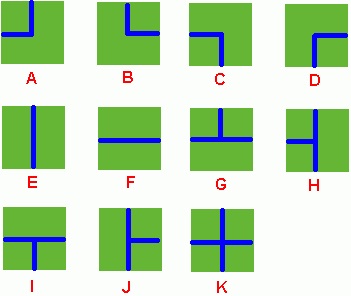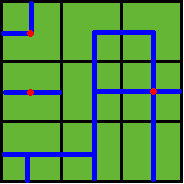转载请注明出处:http://blog.csdn.net/u012860063?viewmode=contents
题目链接:http://acm.hdu.edu.cn/showproblem.php?pid=1198
----------------------------------------------------------------------------------------------------------------------------------------------------------
欢迎光临天资小屋:http://user.qzone.qq.com/593830943/main
----------------------------------------------------------------------------------------------------------------------------------------------------------
Problem Description
Benny has a spacious farm land to irrigate. The farm land is a rectangle, and is divided into a lot of samll squares. Water pipes are placed in these squares. Different square has a different type of pipe. There are 11 types of pipes,
which is marked from A to K, as Figure 1 shows.

Figure 1
Benny has a map of his farm, which is an array of marks denoting the distribution of water pipes over the whole farm. For example, if he has a map
ADC
FJK
IHE
then the water pipes are distributed like

Figure 2
Several wellsprings are found in the center of some squares, so water can flow along the pipes from one square to another. If water flow crosses one square, the whole farm land in this square is irrigated and will have a good harvest in autumn.
Now Benny wants to know at least how many wellsprings should be found to have the whole farm land irrigated. Can you help him?
Note: In the above example, at least 3 wellsprings are needed, as those red points in Figure 2 show.

Benny has a map of his farm, which is an array of marks denoting the distribution of water pipes over the whole farm. For example, if he has a map
ADC
FJK
IHE
then the water pipes are distributed like

Several wellsprings are found in the center of some squares, so water can flow along the pipes from one square to another. If water flow crosses one square, the whole farm land in this square is irrigated and will have a good harvest in autumn.
Now Benny wants to know at least how many wellsprings should be found to have the whole farm land irrigated. Can you help him?
Note: In the above example, at least 3 wellsprings are needed, as those red points in Figure 2 show.
Input
There are several test cases! In each test case, the first line contains 2 integers M and N, then M lines follow. In each of these lines, there are N characters, in the range of 'A' to 'K', denoting the type of water pipe over the
corresponding square. A negative M or N denotes the end of input, else you can assume 1 <= M, N <= 50.
Output
For each test case, output in one line the least number of wellsprings needed.
Sample Input
2 2 DK HF 3 3 ADC FJK IHE -1 -1
Sample Output
2 3
题意:有如上图11种土地块,块中的绿色线条为土地块中修好的水渠,如今一片土地由上述的各种土地块组成。须要浇水,问须要打多少口井。
代码一(dfs):
#include <iostream>
#include <algorithm>
#include <cstring>
using namespace std;
#define TM 117
//存储11中类型的土地。二维中的0 1 2 3分别代表这样的类型的土地的左上右下
//为1表示这个方向有接口,为0表示这个方向没有接口
int a[11][4]={{1,0,0,1},{1,1,0,0},{0,0,1,1},{0,1,1,0},{1,0,1,0},{0,1,0,1},
{1,1,0,1},{1,0,1,1},{0,1,1,1},{1,1,1,0},{1,1,1,1}};
int map[TM][TM];
char s[TM][TM];
bool vis[TM][TM];
int n, m, coun;
void dfs(int x, int y)
{
vis[x][y] = true;
for(int i = 0; i < 4; i++)
{
if(i == 0)//向上查找
{
if(a[map[x][y]][0]&&a[map[x-1][y]][2]&&x-1>=0&&!vis[x-1][y])
dfs(x-1,y);
}
else if(i == 1)//向右查找
{
if(a[map[x][y]][1]&&a[map[x][y+1]][3]&&y+1<m&&!vis[x][y+1])
dfs(x,y+1);
}
else if(i == 2)//向下查找
{
if(a[map[x][y]][2]&&a[map[x+1][y]][0]&&x+1<n&&!vis[x+1][y])
dfs(x+1,y);
}
else if(i == 3)//向左查找
{
if(a[map[x][y]][3]&&a[map[x][y-1]][1]&&y-1>=0&&!vis[x][y-1])
dfs(x,y-1);
}
}
return;
}
void init()//初始化
{
memset(vis,false,sizeof(vis));
coun = 0;
}
int main()
{
int i, j;
while(cin>>n>>m)
{
init();
if(n==-1 && m==-1)
break;
for(i = 0; i < n; i++)
{
cin>>s[i];
for(j = 0; j < m; j++)
{
map[i][j] = s[i][j]-'A';
}
}
for(i = 0; i < n; i++)
{
for(j = 0; j < m; j++)
{
if(!vis[i][j])
{
coun++;
dfs(i,j);
}
}
}
cout<<coun<<endl;
}
return 0;
}代码二:(并查集)
#include <iostream>
#include <algorithm>
using namespace std;
#define TM 117
//存储11中类型的土地。二维中的0 1 2 3分别代表这样的类型的土地的左上右下
//为1表示这个方向有接口。为0表示这个方向没有接口
int a[11][4]={{1,0,0,1},{1,1,0,0},{0,0,1,1},{0,1,1,0},{1,0,1,0},{0,1,0,1},
{1,1,0,1},{1,0,1,1},{0,1,1,1},{1,1,1,0},{1,1,1,1}};
struct p
{
int f;//记录每块田地水管的分布
int c;//分别对每块田地编号
}map[TM][TM];
char s[TM][TM];
int father[TM*TM];
int n, m, coun, k;
int find(int x)
{
return x==father[x]?x:father[x]=find(father[x]);
}
void init()//初始化
{
for(int i = 0; i <= n*m; i++)
{
father[i] = i;
}
coun = k = 0;
}
void Union(int x, int y)
{
int f1 = find(x);
int f2 = find(y);
if(f1!=f2)
{
father[f2] = f1;
}
}
void F(int x, int y)
{
for(int i = 0; i < 4; i++)
{
if(i == 0)//向上查找
{
if(a[map[x][y].f][0]&&a[map[x-1][y].f][2]&&x-1>=0)
{
Union(map[x][y].c,map[x-1][y].c);
}
}
else if(i == 1)//向右查找
{
if(a[map[x][y].f][1]&&a[map[x][y+1].f][3]&&y+1<m)
{
Union(map[x][y].c,map[x][y+1].c);
}
}
else if(i == 2)//向下查找
{
if(a[map[x][y].f][2]&&a[map[x+1][y].f][0]&&x+1<n)
{
Union(map[x][y].c,map[x+1][y].c);
}
}
else if(i == 3)//向左查找
{
if(a[map[x][y].f][3]&&a[map[x][y-1].f][1]&&y-1>=0)
{
Union(map[x][y].c,map[x][y-1].c);
}
}
}
}
int main()
{
int i, j;
while(cin>>n>>m)
{
init();
if(n==-1 && m==-1)
break;
for(i = 0; i < n; i++)
{
cin>>s[i];
for(j = 0; j < m; j++)
{
map[i][j].f = s[i][j]-'A';
map[i][j].c = k++;
}
}
for(i = 0; i < n; i++)//分别对每块田地查找是否和别的田地的水管联通
{
for(j = 0; j < m; j++)
{
F(i,j);
}
}
for(i = 0; i < n; i++)
{
for(j = 0; j < m; j++)//查找有多少个独立的集合
{
if(father[map[i][j].c] == map[i][j].c)
coun++;
}
}
cout<<coun<<endl;
}
return 0;
}